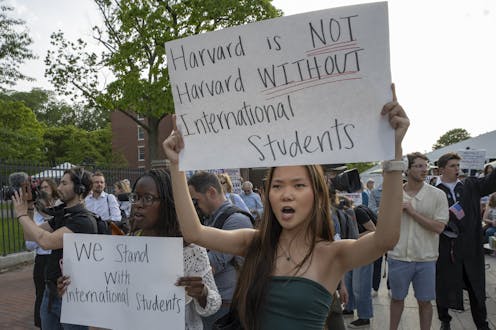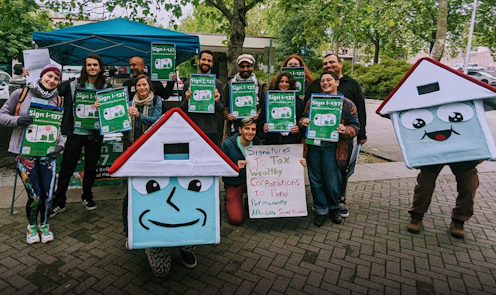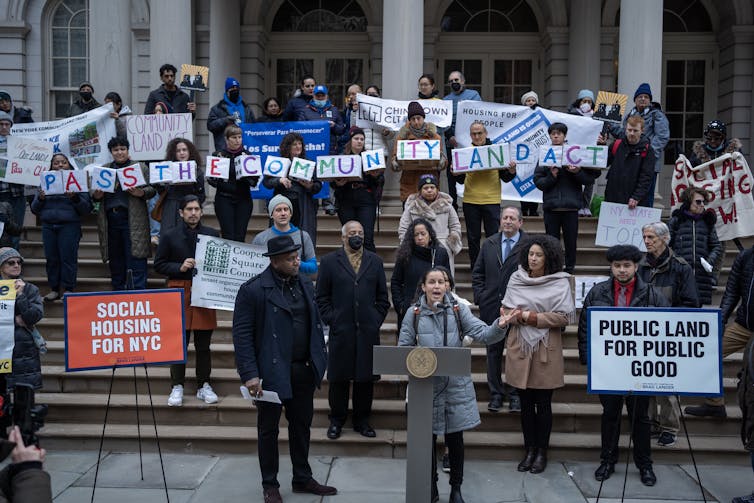Source: The Conversation – USA – By Marc Zimmer, Professor of Chemistry, Connecticut College

Despite representing only 4% of the world’s population, the United States accounts for over half of science Nobel Prizes awarded since 2000, hosts seven of The Times Higher Education Top 10 science universities, and incubates firms such as Alphabet (Google), Meta and Pfizer that turn federally funded discoveries into billion-dollar markets.
The domestic STEM talent pool alone cannot sustain this research output. The U.S. is reliant on a steady and strong influx of foreign scientists – a brain gain. In 2021, foreign-born people constituted 43% of doctorate-level scientists and engineers in the U.S. They make up a significant share of America’s elite researchers: Since 2000, 37 of the 104 U.S. Nobel laureates in the hard sciences, more than a third, were born outside the country.
China, the U.S.’s largest competitor in science, technology, engineering and math endeavors, has a population that is 4.1 times larger than that of the U.S. and so has a larger pool of homegrown talent. Each year, three times as many Chinese citizens (77,000) are awarded STEM Ph.D.s as American citizens (23,000).
To remain preeminent, the U.S. will need to keep attracting exceptional foreign graduate students, budding entrepreneurs and established scientific leaders.
Funding and visa policies could flip gain to drain
This scientific brain gain is being threatened by the Trump administration, which is using federal research funding, scholarships and fellowships as leverage against universities, freezing billions of dollars in grants and contracts to force compliance with its ideological agenda. Its ad hoc approach has been described by higher education leaders as “unprecedented and deeply disturbing,” and a Reagan-appointed judge ruled that 400 National Institutes of Health grants be reinstated because their terminations were “bereft of reasoning, virtually in their entirety.”
Experts caution that these moves not only risk immediate harm to scientific progress and academic freedom but also erode the public’s trust in science and education, with long-term implications for the nation’s prosperity and security.
Citing national security concerns, the White House has also targeted visas for Harvard University’s international students and instructed embassies worldwide to halt visa interviews for all international students, citing national security and alleged institutional misconduct. Against a backdrop of court injunctions and legal appeals, the government continues its heightened “national-security” vetting, so thousands of international scholars remain in limbo.
These measures, combined with travel bans, intensified scrutiny and revocations of existing visas, have disrupted research collaborations and threaten the nation’s continued status as a global leader in science and innovation.
What US misses with fewer foreign scientists
The U.S. research brain gain starts with the 281,000 foreign STEM graduate students and 38,000 foreign STEM postdoctoral scholars who annually come to the U.S. I am one of them. After earning my bachelor’s and master’s degrees in South Africa, I left in 1986 to avoid the apartheid‑era military service, completed my chemistry doctorate and postdoc in the U.S., and joined the United States’ brain gain. It’s an opportunity today’s visa climate might have denied me.

Clement Mahoudeau/AFP via Getty Images
Incentives for the best and brightest foreign science students to come to the U.S. are diminishing at the same time its competitors are increasing their efforts to attract the strongest STEM researchers. For instance, the University of Hong Kong is courting stranded Harvard students with dedicated scholarships, housing and credit-transfer help. A French university program, Safe Place for Science, drew so many American job applicants that it had to shut the portal early. And a Portuguese institute reports a tenfold surge in inquiries from U.S.-based junior faculty.
Immigrants import new ways of thinking to their research labs. They come from other cultures and have learned their science in different educational systems, which place different emphases on rote learning, historical understanding and interdisciplinary research. They often bring an alternative perspective that a homogeneous scientific community cannot match.
Immigrants also help move discoveries from the lab to the marketplace. Foreign-born inventors file patents at a higher per‑capita rate than their domestic peers and are 80% more likely to launch a company. Such firms create roughly 50% more jobs than enterprises founded by native-born entrepreneurs and pay wages that are, on average, one percentage point higher.
The economic stakes are high. Growth models suggest that scientific advances now account for a majority of productivity gains in high‑income countries.
L. Rafael Reif, the former president of MIT, called international talent the “oxygen” of U.S. innovation; restricting visas chokes that supply. Ongoing cuts and uncertainties in federal funding and visa policy now jeopardize America’s scientific leadership and with it the nation’s long‑term economic growth.
![]()
Marc Zimmer received funding from NIH and NSF.
– ref. Turbulent research landscape imperils US brain gain − and ultimately American prosperity – https://theconversation.com/turbulent-research-landscape-imperils-us-brain-gain-and-ultimately-american-prosperity-258537
















